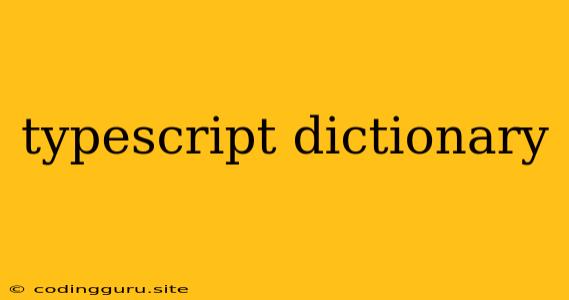Understanding and Using TypeScript Dictionaries
TypeScript, a superset of JavaScript, brings strong typing to your code, enhancing readability, maintainability, and catching errors during development. One powerful feature of TypeScript is its ability to work with dictionaries, offering a flexible way to represent data as key-value pairs. But what exactly are TypeScript dictionaries, and how can you effectively leverage them in your projects?
What are TypeScript Dictionaries?
In essence, a TypeScript dictionary is a data structure that allows you to store collections of data in a key-value format. You can think of it as a map or hash table, where each unique key points to a specific value. This is unlike arrays, which use numerical indices to access elements.
Here's the key to understanding TypeScript dictionaries:
- Keys: These are the unique identifiers that you use to access values within the dictionary. They can be strings, numbers, or any other type supported by TypeScript.
- Values: These are the data associated with each key. They can be of any type, including primitive types like numbers and strings, or even complex objects.
Why Use TypeScript Dictionaries?
Here are some compelling reasons why dictionaries can be a valuable asset in your TypeScript projects:
- Flexibility: Dictionaries provide a flexible structure for storing data in a way that suits your specific needs. You can easily associate values with unique keys, allowing for dynamic and efficient data organization.
- Organization: They promote a well-structured and organized approach to managing data. By assigning meaningful keys to values, you enhance code readability and maintainability.
- Lookup Efficiency: Dictionaries are designed for quick lookups of values based on their associated keys. This efficient retrieval is crucial for many applications.
Declaring and Initializing TypeScript Dictionaries
Let's see how to declare and initialize TypeScript dictionaries in your code:
// Declaring a dictionary with string keys and string values
let myDictionary: { [key: string]: string } = {
"name": "John Doe",
"age": "30",
"city": "New York"
};
// Declaring a dictionary with number keys and number values
let myNumberDictionary: { [key: number]: number } = {
1: 10,
2: 20,
3: 30
};
In these examples, we use the {[key: string]: string} syntax to define a dictionary with string keys and string values. The key keyword acts as a placeholder for the key type, and the string after the colon specifies the value type. You can replace string with any other valid TypeScript type, including objects, arrays, and custom types.
Accessing and Modifying Values in TypeScript Dictionaries
To retrieve a value from a dictionary, simply use its key:
// Accessing the "name" value from the dictionary
let name: string = myDictionary["name"];
console.log(name); // Output: John Doe
You can also modify values associated with existing keys:
// Modifying the "age" value in the dictionary
myDictionary["age"] = "35";
console.log(myDictionary); // Output: { "name": "John Doe", "age": "35", "city": "New York" }
Adding and Removing Key-Value Pairs
To add a new key-value pair to a dictionary:
// Adding a new key-value pair
myDictionary["occupation"] = "Software Engineer";
console.log(myDictionary); // Output: { "name": "John Doe", "age": "35", "city": "New York", "occupation": "Software Engineer" }
To remove a key-value pair from a dictionary:
// Removing the "city" key-value pair
delete myDictionary["city"];
console.log(myDictionary); // Output: { "name": "John Doe", "age": "35", "occupation": "Software Engineer" }
Iterating Through TypeScript Dictionaries
To iterate through the key-value pairs in a dictionary, you can use a for...in loop:
// Iterating through the dictionary and logging key-value pairs
for (let key in myDictionary) {
console.log(`Key: ${key}, Value: ${myDictionary[key]}`);
}
// Output:
// Key: name, Value: John Doe
// Key: age, Value: 35
// Key: occupation, Value: Software Engineer
This loop iterates over the keys in the dictionary and prints each key and its corresponding value.
Working with Generic Dictionaries
For greater flexibility and type safety, TypeScript allows you to use generics with dictionaries. Generics allow you to create reusable code that works with different types. Here's an example of a generic dictionary:
// Generic dictionary type
type MyDictionary = { [key: T]: U };
// Using the generic dictionary type with string keys and number values
let myGenericDictionary: MyDictionary = {
"apple": 1,
"banana": 2,
"orange": 3
};
In this example, we define a generic type MyDictionary<T, U>, where T represents the key type and U represents the value type. When we instantiate myGenericDictionary, we specify the key type as string and the value type as number.
TypeScript Dictionaries and Object Literals
TypeScript dictionaries share similarities with object literals, which are often used for data representation. However, there are some key differences to keep in mind:
- Explicit Typing: TypeScript dictionaries require explicit typing, using the
{[key: string]: string}syntax, whereas object literals can have inferred types. - Key Types: Dictionaries support a wider range of key types, including numbers, symbols, and custom types, while object literals typically use string keys.
- Dynamic Keys: Dictionaries allow you to dynamically add or remove keys during runtime, which is not typically the case with object literals.
Examples of TypeScript Dictionaries in Action
1. Storing User Profiles: You can use a dictionary to store information about users, such as their names, email addresses, and account details. Each user can be identified by their unique user ID, serving as the key in the dictionary.
2. Configuring Application Settings: Dictionaries are ideal for storing application configurations. Each setting can be associated with its corresponding value, making it easy to access and modify them.
3. Implementing Caching Mechanisms: Dictionaries can act as a cache for frequently accessed data, improving application performance by reducing the need for repeated calculations or database queries.
Conclusion
TypeScript dictionaries are a powerful tool for organizing, accessing, and managing data in your projects. They offer flexibility, type safety, and efficiency, enhancing your code's readability and maintainability. Understanding and utilizing TypeScript dictionaries effectively can significantly improve your ability to work with data structures and write robust, scalable applications.
